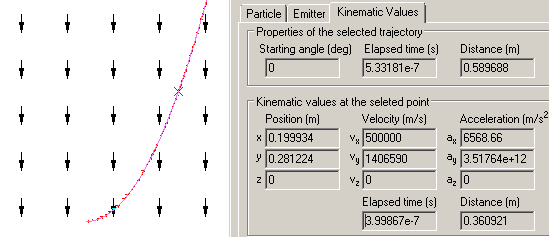Charged particle trajectory in the uniform static electric field. Case: plane-parallel.
QuickField simulation example
Problem Type
Plane-parallel problem of electrostatics.
Geometry
Distance between the plates d = 1 m.
Given
Relative permittivity of vacuum ε = 1;
Positive potential U+ = 20 V.
Charge (electron) q = -1.602e-19 C
Mass (electron) m = 9.109e-31 kg
Initial velocity vx = vx = 500 000 m/s; vz = 0 m/s.
Emitter position (0; 0; 0) m.
Task
Calculate the particle trajectory neglecting relativistic effects.
Solution
The analytical solution gives parabolic trajectory.
x(t) = vx*t [m],
y(t) = 0.5 * Fy / m * t² [m],
z(t) = 0 [m],
where Fy = q*Ey - is the y-component of the Lorentz force,
t - is time.
Particle trajectory may be calculated using the built-in function in QuickField Electrostatic postprocessor or by the free tool TrajectoryTracer.
Results
Electric field strength Ex = 0 V/m, Ey = -20 V/m.
Lorentz force Fy = -1.602e-19 * -20 = 3.204e-18 N.
x(t) = 5e5*t m,
y(t) = 0.5*3.204e-18/9.109e-31 * t² m,
z(t) = 0 m.
Particle coordinates (x; y; z) m | |||
| time | Theory | QuickField | TrajectoryTracer tool |
| 0 s | (0; 0; 0) | (0; 0; 0) | (0; 0; 0) |
| 1e-7 s | (0.050; 0.018; 0) | (0.050; 0.018; 0) | (0.050; 0.018; 0) |
| 2e-7 s | (0.100; 0.070; 0) | (0.100; 0.070; 0) | (0.100; 0.070; 0) |
| 3e-7 s | (0.150; 0.158; 0) | (0.150; 0.158; 0) | (0.150; 0.158; 0) |
| 4e-7 s | (0.200; 0.281; 0) | (0.200; 0.281; 0) | (0.200; 0.281; 0) |
| 5e-7 s | (0.250; 0.440; 0) | (0.250; 0.440; 0) | (0.250; 0.440; 0) |

- View simulation report in PDF
- Download simulation files (files may be viewed using any QuickField Edition).